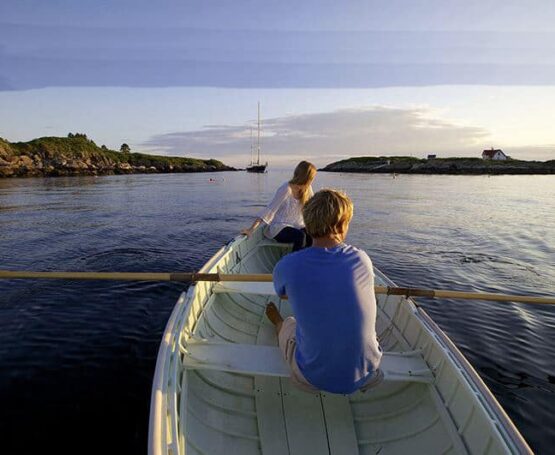
Cruising in Maine can be a most pleasant and satisfying experience, but it requires a considerably higher focus on safety than cruising in other more benign areas and climates. If one is well equipped and aware of Maine's challenges, you will return from a cruise Down East with a unique sense of accomplishment. An introduction to the significant Safety Priorities one faces when cruising in Maine follows.
- Cold Water & Cooler Air Must Be Appreciate as a Safety Hazard
The summer water and air temperatures along the Maine coast are significantly colder than those south of Cape Cod.
Average Temperatures for August: Sea Water Air Temperature
Newport, RI 70F 73F
Portsmouth, NH 62F 69F
Eastport, ME 51F 64F
Falling overboard unexpectedly in Maine is a high-risk proposition and a danger you must plan for when cruising north of Cape Cod. PLEASE read about the Gasp Reflex or Cold Water Shock caused by sudden immersion into water colder than 70 degrees F. https://guides.cruisingclub.org/cold-water-immersion-strategies
For those who enjoy swimming in saltwater, Maine can be challenging, even for the hardiest ocean swimmers. The rest of us mere mortals will want to wear a wet suit before spending any time in the water. If you have to cut a lobster pot warp to free it from your propellor, you will want a shortie wetsuit, a wetsuit hood, serrated knife, goggles, and rugged gloves.
The average air temperatures also decline as you head east along the coast. You can have all four seasons on a typical Maine summer day. You will find yourself dressing up and down throughout the day. Warm clothes in the morning, t-shirts & shorts at noon on a sunny day, warmer clothes, and a windbreaker as the wind comes up in the afternoon and then back to winter as the sun begins to set. Wind block fuzzy vests or jackets are incredibly useful.
- Fog Occurs More Often Than One Might Suspect. And in Maine, Fog Can Be THICK
Fog is possible throughout the summer months, but its prevalence declines as one gets into August and September. Modern electronic navigation instruments can take much of the angst out of navigating in the fog. It is essential to make sure your radar, chart plotter, electronic compass, and autopilot are calibrated accurately before using them in the fog. Many people have installed automatic timing devices to turn their boat horns into automated fog signals. Read our Tips for Sailing in Fog.
- Substantial Tidal Highs & Lows, Along With Fast-Moving Currents
Another navigation challenge is the increasing tidal ranges and current strength as one moves east along the coast. Tidal ranges can vary greatly along the Maine coast, with 9 to11-foot ranges in southern Maine areas, all the way up to 19-foot differentials in far eastern towns near Canada.
When anchoring, be aware of the state of the tide and compute the correct amount of scope for high tide. Be mindful of the currents, especially when rounding headlands and transiting narrow channels, as you can be quickly swept onto rocks. Also, be mindful of Spring or King Tides (higher and lower than average or mean highs and lows). Occasionally, we have "drainers" in Maine that expose another two feet of rock.
- Rocks Are Ubiquitous (Compounded by Over-Reliance On ChartPlotters)
It sounds condescending to say BEWARE OF ROCKS IN MAINE. Everyone knows New Hampshire as the "Granite State," but that descriptor applies even more accurately to the Coast of Maine. So navigate with particular care, especially during periods of low tide.
Chart plotters and tablet charting apps are very useful; however, in Maine, these should be used with CAUTION. It is remarkably easy to become disoriented when among the islands if you are focused on a screen and not on the "big-picture" environment around you. It can be like walking across a street in the city while looking at your phone and not the traffic. You can very easily find yourself on an unforgiving rock ledge. Using a ChartKit or small scale chart in the cockpit can help your situational awareness more than a fixation on the chart plotter screen
- Cell Phones Versus VHF Radio
Communications along the coast also change as you move east. Cell phone service becomes spotty or non-existent. You will find yourself having to rely more on the VHF radio and less and less on your cell phone.
- Lobster Pot Buoys & Warps – More Than A Nuisance
Lobster pots are so numerous you can almost walk ashore on them in some harbors and channels. Getting a pot warp caught in your prop is no fun. If you have a classic sailboat with a full keel, attached rudder, and prop enclosed in an aperture, your problems will be minimal. If you are sailing a modern fin-keel boat with a bulb extending forward of the keel (T Keel), you might think twice about cruising it in Maine. Lobster boat-style cruisers are safer, especially with a prop cage or cutter on the shaft before the prop, than motorboats with pod drives and other exposed running gear. The above-mentioned wet suit gear is essential no matter what type of boat you are cruising in. Read our Tips for Dealing with Lobster Buoys,
- Self-Sufficiency = Self-Satisfaction
Be prepared for fewer services of all kinds as you move east. This applies to land transport, groceries, trash disposal, and marine services such as towing services, marinas, mechanics, and chandleries. It is vital to bring spare engine parts: impellors, belts, fuel filters, etc. If you have the parts, you can always get help installing them -- assuming engine work is not your forte.
If the skipper and crew pay attention to the issues above, a summer sail Down East will be most fulfilling.

